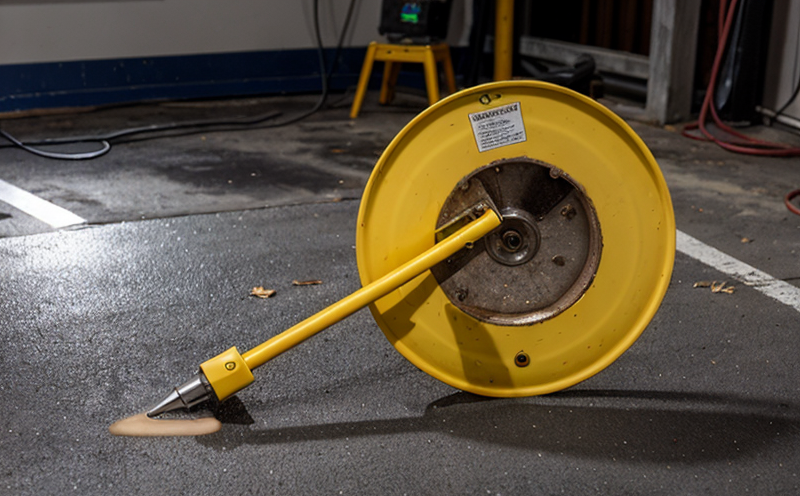ISO 17636 Radiographic Testing of Welded Joints
The ISO 17636 standard is a crucial guideline in ensuring that welded joints meet stringent quality and safety requirements. This non-destructive evaluation (NDE) technique uses radiography to inspect the internal structure of the joint, revealing any defects or imperfections without causing damage to the component being tested.
The primary purpose of this testing method is to assess compliance with design specifications and industry standards. Welded joints are critical in many sectors such as aerospace, automotive, oil & gas, and construction, where structural integrity and safety are paramount. By identifying defects early on through radiographic testing, manufacturers can prevent costly failures and ensure product reliability.
The testing process involves positioning the component to be inspected between a radiation source (usually X-rays or gamma rays) and an imaging device. The radiation penetrates the joint and is absorbed according to the material's density. Defects within the weld cause variations in this absorption pattern, which are captured by the imaging system as contrast on the radiograph. Technicians then analyze these images to assess the quality of the weld.
For ISO 17636 compliance, it is essential that the testing parameters adhere strictly to the standard's requirements. This includes selecting an appropriate radiation source and ensuring proper shielding to minimize exposure to non-target areas. Calibration of the imaging equipment and regular verification of test results are also critical steps in maintaining accurate and reliable inspection outcomes.
Specimen preparation for ISO 17636 testing involves thorough cleaning and degreasing of the weld area, followed by precise alignment under the radiation source. The use of reference standards such as penetrameters helps ensure consistent and repeatable test results. Once the radiograph is captured, it undergoes detailed analysis to identify any indications of defects that may compromise the joint's integrity.
Accurate reporting of findings is another key component of ISO 17636 testing. Reports should include detailed descriptions of the inspection setup, including radiation type and energy level used, along with a comprehensive assessment of any detected defects. Compliance officers rely on these reports to make informed decisions about product quality and safety.
In addition to its primary function in detecting flaws within welded joints, ISO 17636 radiographic testing plays an important role in the research and development (R&D) process. Engineers can use this data to refine welding techniques and materials, leading to improvements in product performance and durability.
The standard also ensures that manufacturers adhere to international best practices for quality assurance. By adhering to ISO 17636 guidelines, companies demonstrate their commitment to producing high-quality products that meet stringent safety standards.
Understanding the specific requirements of this testing method can help stakeholders make informed decisions about when and how to implement it in their operations. For instance, regular inspections using ISO 17636 can be scheduled as part of routine maintenance or during product lifecycle assessments.
To maximize the effectiveness of ISO 17636 radiographic testing, it is advisable to consult with experienced professionals who understand both the technical aspects and practical applications of this standard. They can provide valuable insights into optimizing inspection protocols and interpreting results accurately.
Eurolab Advantages
At Eurolab, we pride ourselves on offering comprehensive services that meet or exceed industry standards. Our expertise in ISO 17636 radiographic testing is complemented by state-of-the-art facilities and experienced personnel who ensure accurate and reliable results.
- Accurate Calibration: We maintain our equipment to the highest level of precision, ensuring consistent and repeatable test results.
- Comprehensive Reporting: Our reports provide detailed insights into inspection setups and findings, facilitating informed decision-making for quality assurance teams.
- Expert Guidance: Our team offers valuable advice on optimizing inspection protocols to suit individual needs.
We understand that every project has unique requirements. That's why we tailor our services to meet those specific demands while adhering strictly to relevant international standards like ISO 17636.
International Acceptance and Recognition
- Widespread Adoption: ISO 17636 radiographic testing is widely recognized across various industries, including aerospace, automotive, oil & gas, construction, and more.
- Global Compliance: Many countries have adopted this standard as a benchmark for ensuring the quality of welded joints. This global recognition enhances trust in products that meet these stringent requirements.
The widespread adoption of ISO 17636 reflects its importance in maintaining high levels of safety and reliability across diverse sectors.
Environmental and Sustainability Contributions
- Eco-Friendly Materials: By using advanced materials that are more durable and require less maintenance, ISO 17636-compliant products contribute positively to environmental sustainability.
- Reduced Waste: Accurate testing leads to fewer rejections during manufacturing processes, reducing waste generation throughout the supply chain.
The emphasis on precision in ISO 17636 radiographic testing contributes significantly to sustainable practices by minimizing errors and ensuring resource efficiency.





